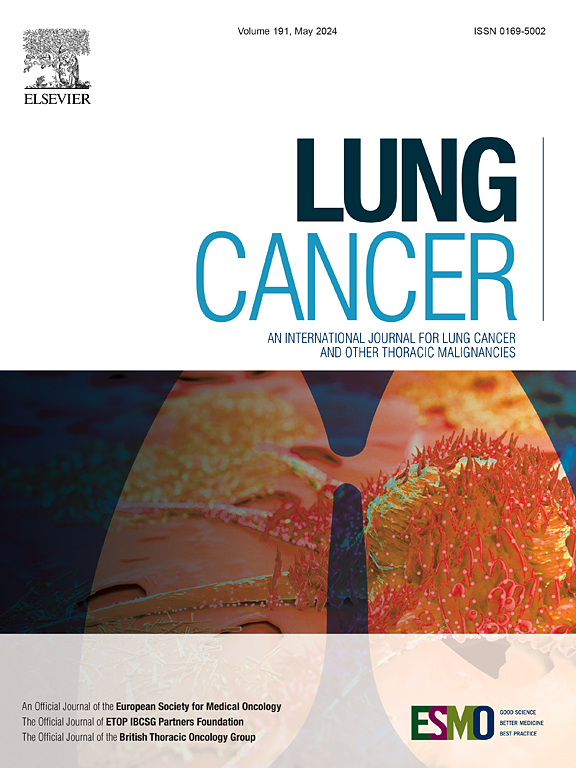非小细胞肺癌手术中,术前肌少症和免疫营养障碍对术后效果的临床影响。
IF 4.4
2区 医学
Q1 ONCOLOGY
引用次数: 0
摘要
研究目的本研究旨在明确接受手术切除的非小细胞肺癌(NSCLC)患者术前肌肉疏松症和预后营养指数(PNI)状态与临床病理因素之间的关系,并根据肌肉疏松症和预后营养指数状态作为预后预测因素进行分层,评估短期和长期预后:本研究纳入了 300 名接受肺叶切除术的 I-IIIA 期 NSCLC 患者。采用骨骼肌指数(SMI)评估 "肌肉疏松症",采用免疫营养指数(PNI)评估免疫营养指数。以第一四分位数作为肌肉疏松症/非肌肉疏松症组和免疫营养指数低/高组的分界线:患者年龄中位数为 70 岁,184 名患者(61.3%)为男性。男性和女性患者的 PNI 中位数为 50.2,SMI 中位数分别为 48.1 和 37.5。中位随访期为 64 个月(60 名患者死亡)。生存分析显示,肌少症组和低 PNI 组的总生存率明显低于对照组(P = 0.002 和 P 结论:肌少症组和低 PNI 组的总生存率明显低于对照组:术前肌肉疏松症和免疫营养障碍的组合对临床产生了负面影响,而与肿瘤因素无关,具有这两种适应症的患者预后特别差。这些因素可能与针对术后复发的药物治疗反应不佳有关。利用术前成像评估骨骼肌质量和利用血清标记物进行营养评估可能有助于围手术期管理和预后预测。本文章由计算机程序翻译,如有差异,请以英文原文为准。
Clinical impact of preoperative sarcopenia and immunonutritional impairment on postoperative outcomes in non-small cell lung cancer surgery
Objectives
This study aimed to clarify the relationship between preoperative sarcopenia and prognostic nutritional index (PNI) statuses and clinicopathological factors in patients with non-small cell lung cancer (NSCLC) who underwent surgical resection, and to evaluate short- and long-term outcomes by stratifying groups according to sarcopenia and PNI status as prognostic predictors.
Materials and methods
This study included 300 patients with p-Stage I-IIIA NSCLC who underwent complete resection with lobectomy. Sarcopenia was assessed using the skeletal muscle index (SMI) and the immunonutritional index was evaluated using the PNI. The first quartile was used as the cutoff for the sarcopenia/non-sarcopenia and low/high-PNI groups.
Results
The median patient age was 70 years, and 184 patients (61.3 %) were male individuals. The median PNI was 50.2, and the median SMI was 48.1 and 37.5 for male and female patients, respectively. The median follow-up period was 64 months (60 patients died). Survival analysis showed that overall survival was significantly worse in the sarcopenia and low-PNI groups than in the control group (p = 0.002 and p < 0.001, respectively). When stratified by sarcopenia and PNI status, the sarcopenia with low-PNI group had a particularly poor prognosis (5-year survival rate, 52.8 % [p < 0.001]). Multivariable Cox regression analysis revealed that sarcopenia with low PNI was an independent prognostic factor that indicated a poor outcome. The response to drug treatment for postoperative recurrence was significantly worse in the sarcopenia with low-PNI group than in the other group.
Conclusion
The combination of preoperative sarcopenia and immunonutritional impairment had a negative clinical impact independent of tumor factors, and patients with these two indications had a particularly poor prognosis. These factors may be associated with poor responses to drug treatment for postoperative recurrence. The evaluation of skeletal muscle mass using preoperative imaging and nutritional assessment using serum markers may be useful for perioperative management and prognosis prediction.
求助全文
通过发布文献求助,成功后即可免费获取论文全文。
去求助
来源期刊

Lung Cancer
医学-呼吸系统
CiteScore
9.40
自引率
3.80%
发文量
407
审稿时长
25 days
期刊介绍:
Lung Cancer is an international publication covering the clinical, translational and basic science of malignancies of the lung and chest region.Original research articles, early reports, review articles, editorials and correspondence covering the prevention, epidemiology and etiology, basic biology, pathology, clinical assessment, surgery, chemotherapy, radiotherapy, combined treatment modalities, other treatment modalities and outcomes of lung cancer are welcome.
 求助内容:
求助内容: 应助结果提醒方式:
应助结果提醒方式:


